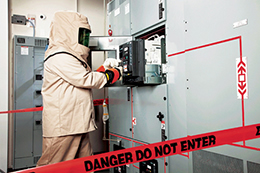| November 2017 | ||
 Print Print  Email Email |
Archive | |

| www.ibew.org |
|
 |
|

|

The New World of Arc-Rated Gear Two years ago, the dress code for millions of U.S. workers, including more than half of the IBEW's members, changed. For the first time, the Occupational Safety and Health Administration changed parts of its standards covering construction and general industry to make fire resistant and arc-rated clothing personal protective equipment and then required employers to provide it to workers who need it. The stakes are very high. While most injuries to electrical workers each year are from electrocutions, arc flashes injure five to 10 electricians every day. Every other day, on average, one of them dies. And the injuries suffered are often catastrophic. Only one-third of arc flash victims are back at work within two months. More than 60 percent, according to a Canadian study, were not back after three months. Because of advances in materials science, every injury from an arc flash can be prevented if proper precautions are taken and the appropriate gear is worn correctly. Changes to the standards were designed to put that gear in the hands of every worker exposed to the risk of an arc flash. "As dangerous as it is to stand inches from a lightning strike, for the first time ever, we have equipment that will protect our members from burns — if they match it to the job and wear it correctly," said IBEW Safety Director Dave Mullen. "It's the company's job to make it available; but in the end, each of us has the ultimate responsibility for our own safety." The safety standard change created a gold rush for manufacturers of arc-rated garments. Dozens of new companies entered the market. New brands using new materials suddenly appeared marketing fire resistant and arc-rated gear in hundreds of new styles. The challenge for IBEW members is that two people wearing what look like identical outfits could have wildly different levels of protection. The difference could be walking away from an arc flash shaken with maybe some red and raw skin and permanent injury or even death. In this special report from the Electrical Worker, we explain how the market for arc-rated work gear has changed, how to understand the rating systems and how to care for and inspect your gear. |

|
© Copyright 2017 International Brotherhood of Electrical Workers | User Agreement and Privacy Policy | Rights and Permissions |